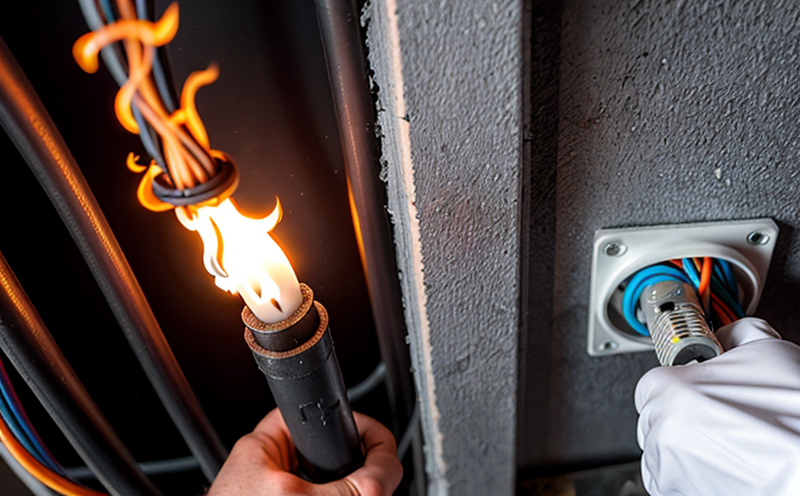Fire Resistance Testing of Control and Instrumentation Cables
The fire resistance testing of control and instrumentation cables is a critical procedure aimed at ensuring that these specialized cables can withstand exposure to extreme temperatures without compromising on their essential functions. In sectors such as aerospace, oil and gas, and power generation, where continuous monitoring and control are vital for safety and operational efficiency, the integrity of control and instrumentation cables becomes paramount.
These cables are designed with specific materials that offer resistance against fire, but they must be thoroughly tested to ensure compliance with industry standards. Testing involves exposing the cable samples to controlled environments that simulate real-world conditions where these cables might experience high temperatures or flames. The tests help determine the maximum temperature a cable can withstand before its insulation starts to fail, thus ensuring safety and reliability.
Fire resistance testing is not just about confirming compliance with regulations but also about safeguarding lives and assets in potentially hazardous environments. For instance, in the case of power plants where control cables manage critical systems, failure could lead to catastrophic events. The results from these tests play a crucial role in the design and certification processes, ensuring that only reliable products are used.
The testing process typically involves placing a sample of the cable into an oven or furnace, gradually increasing the temperature until it reaches a specific point where the insulation begins to degrade. This degradation is monitored using thermal cameras and other sensing devices. The duration required for this degradation is measured, providing valuable data on the fire resistance properties.
The acceptance criteria for these tests are strictly defined by relevant standards such as ISO 7542-1 and ASTM E1689. These standards specify the parameters to be considered, including temperature increments, observation times, and acceptable limits of degradation. Compliance with these standards ensures that the cables meet the necessary safety requirements.
Preparation for fire resistance testing is crucial as it directly impacts the accuracy and reliability of the results. Samples must be cut from the cable according to specific dimensions required by the test method. The samples are then cleaned, dried, and inspected to ensure they meet all specified criteria before being subjected to the heat.
Instrumentation plays a vital role in this testing process. Advanced thermal cameras help monitor the temperature rise of the sample throughout the test duration. Other instruments measure electrical resistance changes that could indicate insulation damage due to overheating or fire exposure.
Industry Applications
| Industry Sector | Application |
|---|---|
| Aerospace | Control and instrumentation cables are used in aircraft to manage critical systems such as engine controls, communication networks, and safety features. |
| Oil & Gas | Cables in oil rigs and platforms must be fire-resistant to ensure continuous operation even under high-temperature conditions. |
| Power Generation | In power plants, control cables are essential for monitoring and controlling various processes such as fuel supply and exhaust gas handling. |
The aerospace industry relies heavily on these cables due to their critical role in managing aircraft systems. In oil and gas operations, fire-resistant cables ensure that even when facing extreme temperatures or accidental fires, the operational continuity of rigs and platforms is maintained. Similarly, power generation facilities require robust control and instrumentation cables to manage sensitive processes without interruptions.
- Aerospace: Ensures safe operation of aircraft systems.
- Oil & Gas: Maintains rig and platform functionality under high temperatures.
- Power Generation: Provides reliable monitoring and control in critical environments.
Quality and Reliability Assurance
- Compliance with international standards ensures that the cables meet necessary safety requirements.
- Advanced instrumentation provides precise data on temperature changes and insulation integrity during testing.
The quality assurance process for fire resistance testing involves several stages, each aimed at ensuring the accuracy and reliability of the results. Compliance with international standards such as ISO 7542-1 and ASTM E1689 is essential to ensure that the cables meet the necessary safety requirements. These standards provide clear guidelines on the parameters to be considered during testing, including temperature increments, observation times, and acceptable limits of degradation.
Advanced instrumentation plays a crucial role in this process. Thermal cameras are used to monitor the temperature rise of the cable sample throughout the test duration. Other instruments measure electrical resistance changes that could indicate insulation damage due to overheating or fire exposure. These measurements provide valuable insights into the performance of the cables under extreme conditions.
The use of such advanced technology ensures that the testing process is both accurate and reliable, leading to higher confidence in the results. This reliability is crucial for industries where safety and operational continuity are paramount.
Use Cases and Application Examples
In aerospace applications, control and instrumentation cables are used in aircraft to manage critical systems such as engine controls, communication networks, and safety features. These cables must be fire-resistant to ensure that the aircraft can continue operating safely even in the event of a fire or other emergencies.
In oil and gas operations, fire-resistant cables are essential for ensuring continuous operation of rigs and platforms under high-temperature conditions. Even in the presence of accidental fires, these cables help maintain the functionality of critical systems, thereby minimizing downtime and potential hazards.
Similarly, in power generation facilities, control cables are used to monitor and control various processes such as fuel supply and exhaust gas handling. Fire resistance is crucial here because interruptions could lead to catastrophic failures that disrupt essential operations. The use of these cables ensures reliable performance under extreme conditions, enhancing overall safety and operational efficiency.





